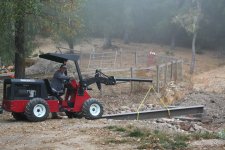I believe that the greatest lifting capacity is at the point where the hydraulic cylinders contact the lifting arms, or behind the lifting point. You have to work out the math to add distance from the point of contact. Theoretically, if you have a 3000 lbs lifting cylinder, it will lift 3000 lbs, plus maybe some reserve. What would the lifting capacity be at 1 ft, 2 ft, etc. An analogy might be something like, a person might lift a 5 gal bucket of water, up close the the body, but try to lift the 5 gal bucket of water with a straight arm. Very difficult. The further out you try to lift, the load capacity will decrease
